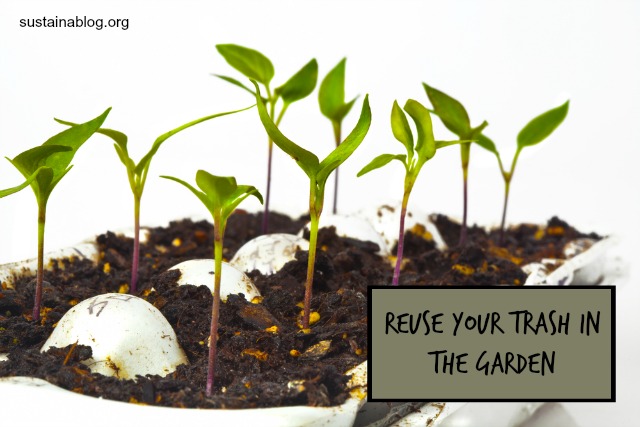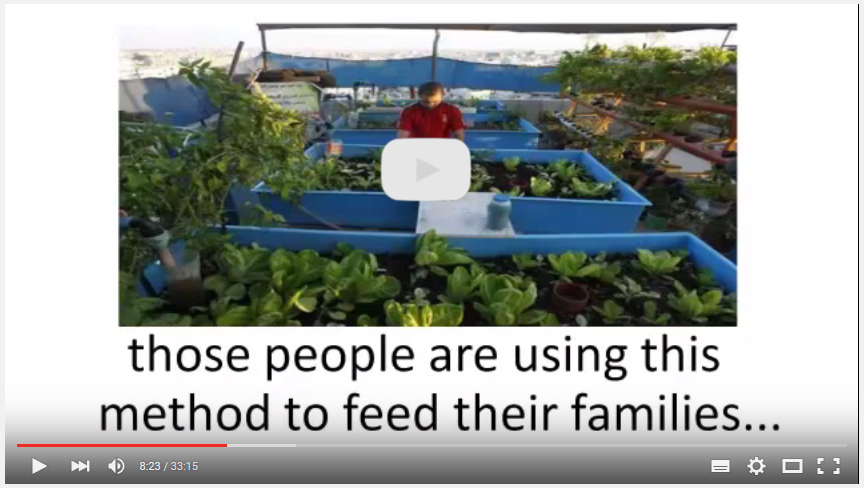
For those in colder climes, Winter is the perfect time to start preparing for your next growing season. One thing you may want to start considering: how can you take items out of the trash and recycling bins, and reuse them in your garden. Let’s take a look at the largest contributors to the home garbage can, and how “garden recycling” might be appropriate for them.
Food Packaging: Many packaging materials are perfect for repurposing in the garden. Buying in bulk, bringing your own containers and using cloth bags are great ways to lessen the amount of packaging that ends up in your recycling or garbage container, but you may still find your bin full of almond milk jugs, egg cartons, netting from onions and avocados, and foil trays. ( Reusing garbage in a post SHTF world ).
- Wash out large plastic jugs and save for your garden. Milk containers with the bottoms removed and the lid on, create a warm home to protect young seedlings from early frosts—just remember to remove in the morning before the sun gets too hot inside. These same containers can be inverted near your squash or pumpkin plants—filled with water and a few punctures— to provide much-needed water during dry times in your garden.
- Egg cartons provide tiny little compartments to start slow-growing seeds. When ready to plant, just cut the individual paper molded dimple and plant in the soil. The recycled paper carton will slowly decompose.
- Netting from produce bags can provide a sling to support your vertical squash and melon fruits. Tie the mesh to the trellis and gently cradle your growing fruit. Be sure to provide lots of room and check it periodically—to ensure the fruit doesn’t grow into the pouch.
- Aluminum trays can be used to reflect light underneath your plants—especially those varieties that have shade-loving pests or could use a boost of photosynthesis for additional growth.
Cardboard and Paper: Have lots of uses in the garden, so don’t put this valuable resource into the recycling bin!
- Shredded newspaper, toilet roll tubes and wets leaves make a cozy bed for red wiggler worms. Vermicomposting is perfect for apartment dwellers who want to create beautiful worm castings for their potted plants while composting their veggie scraps.
- Layers of cardboard, newspaper, grass clippings and compost can turn a resource-sucking lawn into a fabulous raised bed.
- Placing shoe boxes or larger corrugated boxes upside down on larger plants can protect them from a late frost.
- Paper bags can be used to dry herbs or seeds. Not only does the bag keep the dust off your leaves, but often just shaking the bag will cause the dried seeds to fall to the bottom—saving you time and making little mess.
Food and Food Scraps: If you don’t live with teenage garbage compactors, you may find yourself with leftover food that is better used for botulism testing. And even if you do have some hearty eaters in your family, you probably still have vegetable scraps and fruit peelings that need to go somewhere.
- Worm composting (or vermicomposting) creates rich fertile worm castings from cardboard, leaves and table scraps. Worms can turn your vegetable and fruit scraps into nutrient-rich castings. But be careful of potato peelings, they often can grow into potato plants in the earthy, dark environment.
- Build a compost bin and complete the lifecycle from leftover to new veggies. Numerous articles, blogs and books detail the ins and outs of compost bin building. “Just remember to either have an enclosed container (that is pest and rodent proof) or keep your compost bin away from your house. Otherwise you may be inviting unwanted pests into your home” advises Bill Horgan (a pest and wildlife expert).
Think Big: Larger items take up more space in the landfill. So here are some ideas to repurpose those bigger pieces.
- Old bathtubs can be turned into raised beds.
- Frayed or stained tablecloths and sheets make great overnight row covers.
- Old windows provide the perfect top for a small cold frame to protect delicate seedlings in the early Spring, or the cold frame can extend your growing season later into the Fall.
<<Best selection of SURVIVAL BOOKS>>
Get Creative: When getting rid of stuff, start thinking about how it can be repurposed.
- Almost anything natural can be turned into compost: cotton and wool dryer lint can be composted, along with human and pet hair.
- Human waste can be turned into beautiful compost. It’s called humanure and is a great way to for humans to avoid pooping in our drinking water. No other land animal does, why haven’t we figured it out yet?
- Urine is a nitrogen treasure trove. One part urine with nine parts water provides great fertilizer for plants. See http://richearthinstitute.org/ for more info!
- Trimmed branches can be remodeled into trellises for climbing beans or supports for floppy pepper plants.
RELATED: Indoor Survival Gardening
What creative ways have you turned your waste into abundance?
When not looking at garden porn (also known as seed catalogs in politer circles), Sheila Haab explores permaculture concepts, dabbles in fermentation of sourdough and kraut, and immerses herself in the lives of tragic book characters.
Photo credit: Shutterstock
Via Sustainablog
Self-sufficiency and Preparedness solutions recommended for you:
Food for Freedom (If I want my family to survive, I need my own food reserve)
Alive After the Fall (Build yourself the only unlimited water source you’ll ever need)
BulletProof Home (A Prepper’s Guide in Safeguarding a Home )
Survival System (Learn The 7 Secrets Every Family Must Know To Survive Any Disaster Or Crisis Situation)




Wow, I see SO many red flags and not very well thought out issues with this article. READER BEWARE! There are good ideas in there, just be careful.
Toilet paper rolls and egg carton cells take FOREVER to decompose and restrict root expansion.
Paper bags would be good for STORING only, not drying. You need LOTS of air movement to dry things. Paper bags would be a great mold generating environment.
That is just TWO of the things I saw.